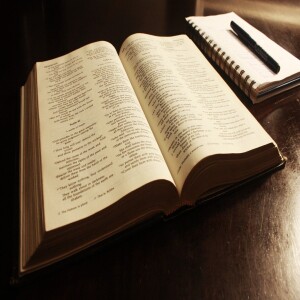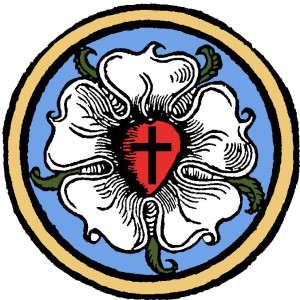
Last week, we heard God’s warning of judgment not only for the sinful people of Judah, but also for the Chaldeans, the people of the Babylonian empire who would inflict such judgment because of their own evil and sinful violence and worship of idols they had made and even worship of themselves and their own power and strength. God was still in His holy temple, and people needed to wait in silence for Him to act in the right way and time.
Chapter Three began, then, with a prayer of Habakkuk as “the prophet” of God. The prayer is only one verse, verse two. Verse one indicates that what Habakkuk wrote was set to music and likely used in temple worship. The word “Shigionoth” probably describes the style of music, with high emotion, reeling back and forth.
A very similar word is used in Psalm 7. There are musical notations, “Selah,” also at the end of verses 3,9, and 13, as you can find in a number of Psalms, like Psalm 57 and 62. This may have to do with intensified music, as we still have in music today, with notations for being louder and softer (forte and pianissimo). Verse 19 also has a note for the choirmaster in the temple and for use of stringed instruments, that one also finds in some of the psalms. The same Hebrew word for “prayer” is found also in Psalms 17, 86, 90, 102, and 142, regarding prayers by Moses and David and others.
The prayer of Habakkuk, in response to what God had revealed to him, is just verse 2. Habakkuk said that he had “heard” what the Lord said and that His “work” was going to be a “fearful” thing, as He brought judgment. But Habakkuk prayed that in the midst of His “wrath” over sin, God would also “remember His mercy” toward sinners and “revive it” and “make it known” in the midst of many years to come. Habakkuk was praying that God would remember His promises to His people and especially the promise of the coming Messiah and His salvation.
Habakkuk 3:3-15 is God’s response back to Habakkuk and his prayer. As God responded to Habakkuk, He used many Old Testament words and images about what He had already done for His people and in the world. It was a way of saying that as God had done in the past, He would remember and do in His great power again, in showing mercy to His people.
Verses 3-5 use words from Deuteronomy 32:40-43 and 33:1-3, as “The Lord came from Mt. Sinai” in great glory with His holy ones, “with flaming fire” and “brightness” that shone from Seir (Teman) and from Mount Paran. This refers to His giving the Law to Moses and appearing like the sun, with its “rays” shining forth. Moses only had glimpses of the true glory of God and yet “shone” himself as he came down from the mountain. We know that our eyes could be damaged by staring at the sun. How much worse it would be for us sinners to see the Holy God now.
The power and judgment of God are also pictured in verses 5-7, with “pestilence and plague,” as happened with the Egyptians, when God rescued His people from them,, and earthquakes and the shaking of mountains and nations, as God’s people were brought into the Promised Land. Nomadic peoples like the “Midianites” and “Cushans,” who lived in “tents,” in “curtains,” trembled before God and His people, as they passed through. (In verse 7, Habakkuk said, “I saw” these things. Maybe God was giving him a vision, a glimpse of all these past events.)
Verses 8-10 refer to “rivers” and “the sea” and “raging waters” and “the deep” going forth. These seem to refer to events like the great flood (see Genesis 7:6,11 and 8:2) and God’s people passing through the Red Sea and the Jordan River and other such evidences of God’s power. Verse 10 may be a reference to when the sun stood still in Joshua 10:12-13 or simply that the sun and moon’s glory retreated at the great light and glory of God’s arrows and spears as He protected His people, as the Hebrew in this verse suggests.
Verse 14 may be an allusion to stories like David’s victory over Goliath, when the stone from his sling hit Goliath’s head and he then beheaded him (1 Samuel 17:41-51); or the story of how Jael killed the leader Sisera by driving a tent peg into his head (Judges 4:21). All these verses, including Habakkuk 3:12-13, picture God judging and defeating the “wicked” with His “spear” and “arrows” and at last, sparing and bringing mercy to His own people - Noah and His family, the children of Israeli and on and on.
God’s “chariots of salvation” (verse 8) were always at work through the centuries, and He worked “for the salvation of His people,” Israel, and especially for the sake of “His Anointed” (verse 13), the coming Savior, Jesus, who would be born through that line of Jewish people. Yet in the midst of all that, God’s people were often sinful and had to go through times of judgment and discipline and be called back to trust in the Lord.
Habakkuk 3:3-15 are difficult, because they speak of and allude to many events we don’t know so well and Scriptures we are not very familiar with. God was making the point, though, that in the past He often had to use “wrath and judgment” upon nations and even upon His own people; but He also always remembered His mercy and forgiveness and His saving plan. As He had done again and again in the past, God would again in the future show mercy to His chosen people. He would answer the prayer of Habakkuk. Even though there would be wrath and great trouble ahead for the Jews, God would again, in His time and plan, remember His mercy and promises.
In Habakkuk 3:16, Habakkuk responded again to God and showed that he had gotten the message. It was very upsetting that His people were going to have to such judgment (even though Habakkuk had in Chapter One complained that God seemed to be doing nothing about that evil in Judah). Habakkuk said, “My body trembles; my lips quiver at the sound; rottenness enters into my bones; my legs tremble beneath me.”
It was going to be horrible to see Jerusalem and the temple and Judah overrun and destroyed and many people taken into captivity in Babylon for many years. Yet, Habakkuk said, “I will wait quietly for the day of trouble to come upon the people, the Babylonians, who invade us.” Justice would finally be done and God’s people would be spared, though it would be about 60-70 years later, with much trouble and suffering in between.
In the meantime, Habakkuk made, in a poetic way, one of the best descriptions of living by faith that is in the Scriptures. Read Habakkuk 3:17-19. Though everything seemed to go wrong (verse 17), Habakkuk would still “rejoice in the Lord” and have faith and joy “in the God of his salvation.” The Lord would be his “strength” and help him to keep going, like a deer still sure-footed in a rugged, mountainous place (Habakkuk 3:18-19). (This is a quotation from Psalm 27:1 and parts of Psalm 18:1-2, 30-35. Take a look at those passages, too.)
You might also read 2 Corinthians 12:7-10. Paul had a ”thorn in the flesh,” some sort of physical ailment or other kind of trouble that would not go away, though he prayed and pleaded with God that it would leave him. God simply said, “My grace is sufficient for you, for my power is made perfect in weakness.” Paul was called simply to live by faith and trust God, no matter what. He said, “For the sake of Christ, then, I am content with weaknesses, insults, hardships, persecutions, and calamities. For when I am weak, then I am strong.”
Next week, we will have some closing comments and think about how we apply “living by faith” to our current world and local situations. What does living by God’s grace through faith mean for us now?
More Episodes
 2023-05-31
2023-05-31
 19
19
 2023-05-22
2023-05-22
 12
12
 2023-05-22
2023-05-22
 13
13
 2023-05-22
2023-05-22
 6
6
 2023-05-16
2023-05-16
 11
11
 2023-05-16
2023-05-16
 9
9
 2023-05-16
2023-05-16
 5
5
 2023-05-08
2023-05-08
 13
13
 2023-05-08
2023-05-08
 15
15
 2023-05-07
2023-05-07
 6
6
 2023-05-02
2023-05-02
 12
12
 2023-05-02
2023-05-02
 17
17
 2023-05-01
2023-05-01
 8
8
 2023-04-24
2023-04-24
 13
13
 2023-04-24
2023-04-24
 17
17
 2023-04-24
2023-04-24
 5
5
 2023-04-17
2023-04-17
 7
7
 2023-04-17
2023-04-17
 13
13
 2023-04-17
2023-04-17
 4
4
Create your
podcast in
minutes
- Full-featured podcast site
- Unlimited storage and bandwidth
- Comprehensive podcast stats
- Distribute to Apple Podcasts, Spotify, and more
- Make money with your podcast
It is Free
- Privacy Policy
- Cookie Policy
- Terms of Use
- Consent Preferences
- Copyright © 2015-2024 Podbean.com






